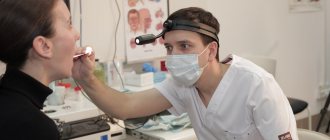- The structure of ENT organs in children
- Physiological features of the cough reflex
- Causes of cough in children
- Does it occur in a healthy person?
- Classification
- What does a severe cough mean?
- What is dry cough
- What to do with a barking cough
- Prevention and treatment of false croup
General information
Cough is a protective mechanism of the respiratory system in response to irritants or sudden changes in the environment. Often, although not an independent pathology, a cough signals a disruption in the functioning of the body. In case of rare coughing attacks without fever in children, there is no need to worry: this is a one-time reaction to irritating particles (for example, dust), smoke or saliva entering the upper respiratory tract. It is normal to cough as a reaction to a sharp change in temperature when inhaling cold air. A cough lasting more than a week is a cause for concern. In the absence of fever and other alarming symptoms, a prolonged cough is always a sign of pathology. Often in children, a cough without fever indicates the development of an allergic reaction. A prolonged cough without fever requires diagnosis, observation and treatment by a specialist: pediatrician, otolaryngologist, allergist. Dangerous complications include bronchial asthma.
Causes of children's cough without fever
A cough without fever indicates the initial stage of development of infectious and inflammatory processes of various etiologies. In other cases, such a cough acts as a secondary symptom of low-grade inflammatory processes. However, not every cough is a pathological symptom. The following are the main causes of non-fever cough in children:
- Formation of the upper respiratory tract. Babies do not swallow saliva, but cough it up due to the structure of the upper respiratory tract. Coughing in children under one year of age is normal if we are talking about a natural reaction to food debris accumulated in the mouth or mucus that has got onto the root of the tongue.
- Chemical or mechanical irritation of the mucous membrane by smoke, dust particles and aerosols. Coughing is a normal reaction to an external irritant.
- Foreign object stuck in the airway. By coughing, the child tries to expel the foreign object.
- Allergic reactions. Allergic cough in children often becomes protracted if the allergen is not identified and eliminated in time. A prolonged cough is fraught with the development of bronchitis and asthmatic pathologies.
- Bronchial asthma. It often develops in childhood as a continuation of an unattended allergic cough. In addition, there is a theory of the neurogenic etiology of bronchial asthma. Children's cough without fever is one of the main symptoms of this pathology.
- Chronic diseases. In children, chronic forms of pathologies such as pharyngitis, adenoids, bronchitis, tonsillitis and sinusitis, in the initial and latent phase, are manifested by a cough in the absence of temperature.
- Pathologies of the gastrointestinal tract. Coughing attacks without fever are a sign of dysfunction of the biliary tract and reflux gastritis.
- Helminthic infestations. Cough without fever in children occurs when infected with parasitic tapeworms.
- Illiterate or incomplete treatment. One of the reasons for cough without fever may be incomplete treatment of ARVI. In this case, the child generally feels well, but continues to cough. The attacks intensify upon returning from a walk in the fresh air, after playing sports and playing activities.
- Excessively dry indoor air. Too dry and warm air in the apartment, dust from toys, raised during the day during play and settled overnight, can irritate the child’s respiratory tract receptors and cause a cough.
- Taking medications, the side effects of which include cough without fever.
In rare cases, an intense cough without fever is one of the symptoms of serious pathologies in a child. Among them are lung cancer, tuberculosis, and cystic fibrosis. Sometimes a feverless cough in children indicates problems with the thyroid gland.
Barking cough
Diphtheria
12715 08 June
IMPORTANT!
The information in this section cannot be used for self-diagnosis and self-treatment.
In case of pain or other exacerbation of the disease, diagnostic tests should be prescribed only by the attending physician. To make a diagnosis and properly prescribe treatment, you should contact your doctor. Barking cough: causes of occurrence, what diseases it occurs with, diagnosis and treatment methods.
Definition
Cough is a physiological protective reaction of the body in response to irritating substances entering the respiratory system (less often, the digestive tract). The respiratory epithelium, which covers the respiratory tract from the inside, protects the body from the penetration of infectious agents (bacteria, viruses, etc.), retains dust particles inhaled with the air on its surface, and also helps cleanse the respiratory tract from them. The cells of the epithelium of the respiratory tract are adjacent quite tightly to each other, forming a barrier that does not allow microbes to pass through. A secretion (mucus) is produced on the surface of the epithelium, which moisturizes the epithelium and air passing through the respiratory tract, and also creates an additional barrier to infection. The respiratory epithelium has special cilia on its surface that help cleanse the walls of the respiratory tract, “washing out” mucus with dust and microorganisms settled on it in the direction from bottom to top.
The mucous membrane of the respiratory tract is well supplied with blood, which ensures warming of air coming from outside, sufficient mucus production and timely transportation of leukocytes (immune cells) to the area where infectious agents enter.
With the development of inflammatory changes in the wall of the respiratory tract or when they are irritated, for example by dust or caustic gases, the cough center is activated.
Types of cough
Depending on the presence of sputum, dry and wet cough are distinguished. Interestingly, these two types of cough can replace each other during the course of the disease.
Based on timbre, coughs are classified into silent, muffled, hoarse and others, among which the barking cough occupies a special place.
When describing this type of cough, it is appropriate to say that it really is somewhat reminiscent of a dog barking: just as loud and sharp, often with a metallic tint.
Possible reasons for the development of a barking cough
A barking cough usually indicates damage to the larynx.
The larynx with the vocal folds located in it plays a key role in the vocal apparatus. The vocal folds are stretched between cartilaginous structures, the degree of their tension is regulated by the laryngeal apparatus. Between the two vocal folds there is a gap through which the air exhaled from the lungs passes, creating oscillatory movements. The length of the vocal folds and the frequency of vibration determine the characteristics of the voice and cough in people with lesions of the vocal apparatus.
Inflammatory diseases of the larynx are grouped under the general name “laryngitis”. Inflammation of the larynx often develops in connection with an infectious lesion of the upper respiratory tract, and isolated inflammation of the larynx occurs quite rarely; much more often, the infectious process spreads to the larynx from the pharynx or trachea. Other causes of laryngitis are thermal injuries (exposure to gaseous substances that have a high temperature), inhalation injury from gaseous caustic chemicals, and allergic processes. Laryngitis develops when the vocal apparatus is overstrained.
Diseases that cause barking cough
Among infectious lesions of the larynx leading to the development of a barking cough, it is customary to distinguish two groups of diseases:
- Diphtheria of the larynx is an infectious disease of a bacterial nature, characterized by the formation of lamellar plaques in the respiratory tract, which are prone to independent separation from the mucous membrane and lead to blockage of the lumen of the respiratory tract, up to a complete disruption of their patency.
This condition is called “true croup” - it is characterized by gradual, steady progression, hoarseness with a further decrease in the volume of the cough. - Acute stenosing laryngotracheitis is an infectious inflammation of the trachea and larynx, leading to obstruction of the airways due to severe swelling of the laryngeal mucosa. This disease is also called false croup, because it is not caused by diphtheria bacillus, but by viruses (parainfluenza, influenza, respiratory syncytial virus) and bacteria - for example, mycoplasma.
False croup usually begins on the 1st–3rd day of a cold, acutely, suddenly, often at night.
A barking cough and severe difficulty breathing are the main signs of this condition.
It is worth saying that true croup affects people who were not vaccinated against diphtheria in childhood.
False croup is a condition characteristic of childhood (usually up to 5 years) - this is due to the structural features of the larynx in children (narrow, with soft cartilage, having a good blood supply to the mucous and submucous membranes), as a result of this structure there is a rapid increase in inflammatory edema and development severe airway obstruction. Which doctors should I contact if I develop a barking cough?
Emergency care for a patient with a barking cough and respiratory distress is usually provided by an emergency physician. Further management of such a patient depends on the cause of the development of barking cough. So, if diphtheria is suspected, the patient is hospitalized in an infectious diseases hospital, where an infectious disease specialist will treat him. If false croup develops in a child, therapy is carried out.
Diagnosis and examinations for barking cough
Diagnosis of a barking cough begins with interviewing the patient (or his parents, if the patient is a child) and finding out the circumstances under which the cough developed. Then the doctor conducts a clinical examination, an integral part of which is examining the oral cavity and listening to breathing sounds using a phonendoscope. Based on the data obtained, a presumptive diagnosis is formed, which requires clarification after the acute condition has been relieved and the risk of developing acute respiratory disorders in the patient has been eliminated.
To diagnose diphtheria, material from the throat and respiratory tract is cultured for the presence of the causative agent of the disease - Corynebacterium diphtheria
.
Types of disease
A child's cough without fever may vary in quality and duration. Depending on the presence or absence of exudate, non-temperature cough can be dry or wet. A dry cough is sometimes accompanied by wheezing and is more often seen with allergic reactions. A wet cough is characterized by the discharge of sputum; it appears with colds, bronchitis, and tuberculosis.
According to the nature of the attacks and their duration, children's cough without fever is divided into:
- paroxysmal cough: the child chokes and complains of severe spasms in the throat;
- rare and short-term cough: normal variant; occurs in response to the presence of a provoking factor immediately at the time of a coughing attack (difference in humidity, temperature, presence of an allergen, mold or dust in the immediate vicinity);
- a prolonged cough without fever does not go away for more than a month and indicates the presence of a strong inflammatory process in the body: asthma, whooping cough, tuberculosis, pleurisy (in the latter case, the cough will be dry);
- deep cough is a symptom of allergies, respiratory pathologies and tumor processes;
- a purulent cough indicates a severe bacterial infection.
A non-temperature cough with painful sensations in the throat before, during and after an attack indicates damage to the mucous membrane or the development of local infectious and inflammatory processes of the nasopharynx: sore throat, pharyngitis, laryngitis.
Cough classification
- by nature: unproductive (dry), productive (wet);
- by intensity: cough, mild, strong;
- by duration: episodic, short-term, paroxysmal, constant;
- according to the course: acute (up to three weeks), prolonged (more than 3 weeks, but less than 8 weeks), chronic (8 weeks or more);
- by depth and strength: sharp, strong and superficial (coughing);
- due to: infectious (viruses, bacteria, fungi), non-infectious (foreign body, dust, dry air, etc.), allergic
| Character | Activity | intensity | Flow | Depth and strength | Cause |
| unproductive (dry) | episodic | coughing | acute (up to 3 weeks) | sharp strong | Infectious (viruses, bacteria, fungi) |
| productive (wet) | short-term | easy | long-term(3-8 weeks) | superficial (coughing) | Non-infectious (foreign body, dust, dry air, etc.) |
| strong | chronic (from 8 weeks) | allergic |
Symptoms of a child's cough without fever
Involuntary physiological coughs during the day normally do not cause discomfort, as the body cleanses itself and reacts to environmental irritants. Spastic types of attacks of a different nature should be regarded as a sign of a pathological process. You should be wary if one or more of the following signs are present:
- copious sputum production with a wet cough;
- painful sensations in the throat with an exhausting dry cough, especially if hoarseness and hoarseness occur after an attack;
- sensation of a foreign body in the respiratory system;
- attacks of suffocation during coughing;
- wave-like repeated bursts of coughing throughout the day;
- regular coughing attacks for more than 3 months in a row (the process of cough chronicization);
- convulsive bronchospasms, causing a prolonged coughing attack (often occurs with allergies and bronchial asthma);
- the child's inability to cough completely;
- hysterical cough up to an attack of vomiting (a symptom of whooping cough);
- “barking” cough (a symptom of croup);
- hoarse and silent cough (vocal cord damage);
- wheezing cough (damage to the bronchi).
A child's cough without fever is more severe than a similar condition in an adult. Finding out its causes should not be delayed.
The structure of ENT organs in children
The human respiratory system has three sections: upper (nose, pharynx), middle (larynx, trachea, bronchi) and lower (alveoli, bronchioles). At birth, the respiratory tract is in the stage of formation, which is associated with the functional characteristics of the breathing of babies. By the age of seven, the development of the respiratory system enters its final stage, after which its size increases.
Children have a narrower lumen of the larynx, and the mucous membrane is thin and tender. The submucosal layer is loose and richly supplied with blood. The cartilage that forms the frame of the respiratory tract is pliable and soft. The above explains the vulnerability of the mucous membrane and the predisposition to easier penetration of infectious and atopic agents into the bloodstream. When inflammation occurs due to swelling, the airways narrow, making it difficult to breathe normally. The glands may secrete excess mucus. During the day, when the child is active, mucus drains well from the respiratory tract, but at night it can irritate the larynx. Separately, it is worth mentioning the reduced production of immunoglobulins and other immunity factors compared to adults.
Physiology of cough
The ability to effectively cough up sputum develops by the age of 4-6 years. Until this age, it, being in the respiratory tract, can interfere with normal breathing. Sputum secretion with normal rheological properties is formed by 5-6 years. Cough medications can be harmful to a young child because, with excess mucus and weakness of the respiratory muscles, they can worsen the cough and cause complications.
Diagnosis of pathology
A pediatrician can perform the initial diagnosis upon treatment. A narrow specialist, an otolaryngologist, is responsible for making an accurate diagnosis and choosing a treatment regimen. An important role in establishing the cause of cough without fever in a child is taken by collecting an anamnesis. It is the responsibility of the attendant to detail the following observations:
- how long and intense the coughing attacks are;
- character of cough: dry, wet, “barking”, “whistling”;
- what becomes a catalyst for coughing: active games and sports, cold air, eating;
- Are there any third-party symptoms accompanying the cough: runny nose, vomiting, snoring;
- is there a correlation between coughing attacks and the time of day;
- whether the child’s emotional state affects the nature and frequency of coughing.
In addition to the conversation, the otolaryngologist will examine the child during the appointment and carry out a number of manipulations and prescriptions, including:
- auscultation, incl. using a phonendoscope;
- radiographic examination and CT;
- examination of bronchial discharge;
- fibrobronchoscopy examination;
- video endoscopic examination of ENT organs.
The nature and duration of the cough, coupled with the accompanying symptoms, allows us to determine the location of the inflammation and make a diagnosis more quickly. During the diagnosis, additional consultation with a pediatric allergist, phthisiatrician, endocrinologist, infectious disease specialist, or immunologist is possible.
Treatment of children's cough without fever
If you suspect a pathological nature of a child’s cough, you should contact a pediatrician or otolaryngologist. Timely treatment will allow for competent cough therapy and avoid complications.
The therapeutic regimen is based on an integrated approach: some of the measures are aimed at relieving coughing, and some are aimed at eliminating its root cause.
Drug therapy includes several groups of drugs:
- antitussives (weakening the cough reflex);
- mucolytic;
- antiallergic;
- antimycotics;
- antibiotics;
- antiviral.
Additionally, a course of inhalations with medicinal solutions (via a nebulizer) may be prescribed. General recommendations include sufficient indoor air humidity, quiet walks, and drinking regime (warm drinks).
Since cough most often acts as a symptom of the underlying pathology, the success of getting rid of it depends on the success of treating the disease that became the root cause. The treatment plan is prescribed by a specialist.
Diagnosis and treatment of bronchitis
Diagnosis of bronchitis in children is important in the overall treatment program. In addition to the disease itself, diagnosis helps determine the form, stage and possible complications. Bronchitis in children is diagnosed in the following ways1:
- Taking anamnesis from the child and parents;
- Detection of cough and determination of its duration;
- Physical diagnosis, including palpation, general external examination and listening to the chest with a phonendoscope;
- X-ray examination.
In most cases, these diagnostic methods are sufficient, and children tolerate them easily. But other diagnostic methods can also be used: complete blood count, spirometry (measurement of lung volume) and bronchography.
Science has accumulated a lot of knowledge about respiratory diseases and their specific pathogens. Methods of treatment and diagnosis in children are used and well studied, but there is still no universal remedy. Treatment must be comprehensive.
One of the interesting and truly important achievements of science in recent years is the refusal to completely prescribe antibiotics for any form of bronchitis. Considering that the disease most often occurs due to viruses, antibiotics do not show themselves in treating the main problem and greatly harm the fragile child’s body. Treatment with antibiotics is recognized as irrational5.
However, chronic bronchitis that is likely or confirmed to be caused by a bacterial infection must be treated with antibiotics or risk serious complications. Everything depends on an accurate diagnosis and determination of the cause of the disease, and then a competent treatment plan must be built.
In most cases, treatment comes down to helping the body fight the viral infection that caused bronchitis. Immunity must enter the battle; it must be helped and given all the conditions for the fight.
Considering the severity of the course and the various causes of the disease, medications for the treatment of bronchitis in children should be prescribed only by the attending pediatrician or ENT3:
- Antipyretics;
- Antitussives;
- Immunostimulants;
- Antiviral drugs;
- Antiallergic drugs;
- Antihistamines;
- Expectorants, mucolytics and bronchodilators;
- Herbal preparations with expectorant effect;
- Antibiotics for the most serious cases of illness.
In the treatment of children, inhalation methods of drug delivery, chest massage and electrophoresis have proven themselves to be effective. Treatment of bronchitis in children at home should include drinking plenty of fluids, air humidification and hypoallergenic food.
Considering that the main cause of bronchitis is a virus, it is worth focusing on maintaining and developing immunity, especially during the cold season. Ancillary medications may be used to support or restore protective functions. Among them, IRS ® stands out, a complex drug based on bacterial lysates6.
The IRS®19 immunomodulator has stood the test of time7. The drug successfully resists pathogenic bacteria on the mucous membranes of the respiratory system, preventing the spread of infection. Its use can significantly reduce the incidence of respiratory diseases, and also reduces the total need for antibacterial and anti-inflammatory therapy8.
The principle of action of the drug is based on immunostimulation. The composition contains bacterial lysates of common infectious agents. IRS®19 activates and stimulates local immunity, thereby holding the gates through which various respiratory infections try to break in. After using the drug, it is easier for the body to cope with bacteria that can settle on the bronchi6.
Forecast
With timely seeking help and competent therapy, the prognosis is favorable. In the case of a prolonged course of children's non-temperature cough (more than 3 weeks), complications may develop or chronicity of pathological processes in the upper respiratory tract. In children, a prolonged cough is more severe than in adults, since the child’s mucous membrane is less adapted to irritants. Lack of treatment can lead to the development of dangerous conditions such as bronchial asthma, bronchitis and pneumonia.
Prevention and treatment of false croup in children
As a preventive measure for recurrent stenosing laryngotracheobronchitis in children, the antiviral drug VIFERON Gel can be used from the first days of life. For treatment in the acute period, if a complication has developed, VIFERON Gel is applied 5 times a day for 5-7 days, then 3 times a day for the next 3 weeks.
Last year, the Russian Medical Journal published an article “Acute respiratory infections in children: optimization of treatment tactics,” which presents research data on the use of the drug VIFERON in the treatment of acute respiratory viral infections and influenza. It is interesting that in children of different ages who received therapy with the inclusion of this drug, positive dynamics were observed faster, on average two days earlier than in the control group:
- body temperature tended to normal,
- symptoms of intoxication decreased,
- the intensity of catarrhal phenomena (cough, runny nose) decreased until it stopped
- respiratory syndrome (difficulty breathing)
Nosocomial infection becomes a common problem for patients undergoing treatment in a hospital. Infection threatens to delay treatment and develop complications in addition to the underlying disease. It is important that children who received VIFERON became infected half as often [1].
Reference and information material
Author of the article
Gerasimenko Igor Olegovich
General doctor
Sources:
- Nikolaeva S.V., Khlypovka Yu.N., Gorelov A.V. Acute respiratory infections in children: optimization of treatment tactics. //RMJ 2019; 1(*): pp.1-5.
i https://nczd.ru/
Loading...
Take other surveys
Prevention
The main prevention of children's cough without fever is to follow general recommendations for maintaining the health of the child's respiratory tract. You can add the following:
- Teach your child to use nasal breathing while walking in the fresh air;
- if the mucous membrane of the throat is irritated, let the child drink a lot of warm liquid;
- maintain a sufficient level of humidity in the apartment, especially in the nursery, where the child spends a significant part of the day;
- at the first sign of cough as a symptom, convince the child to maintain a vocal regime: try not to scream and talk as little as possible;
- Make sure your child's hands, feet and head are always warm.
Causes of cough in children:
– irritation of the mucous membrane of the respiratory tract due to or without infection;
– obstruction of the respiratory tract (entry of foreign particles or objects into the trachea and bronchi);
- compression of the respiratory tract.
In general, there are many causes of cough, including those associated with serious pathologies, but we will not touch on them in this article.
Questions and answers
— Which specialist treats a child’s non-fever cough?
— The initial appointment can be carried out by a pediatrician. An otolaryngologist is responsible for making an accurate diagnosis, choosing diagnostic procedures and prescribing a therapeutic treatment plan. Depending on the cause of a child’s cough without fever, consultation with a specialist in a related field may be necessary.
— What is the normal duration of a child’s cough without fever?
— For children over one year old, we can normally talk about rare coughing attacks as an adequate physiological protective reaction to an environmental irritant. The second case, when there is no reason for concern, is a cough without fever and runny nose lasting no more than two weeks after a recent ENT disease, for example, ARVI or bronchitis. This is how the child’s body tries to get rid of secretory residues in the bronchi.
— What household factors can trigger the development of a child’s cough without fever?
— The most common cause of dry, non-temperature cough in children is household allergies. The role of antigens can be various types of dust, skin particles or animal hair, mold, fungi, microparticles of detergents, pillow feathers, waste products of saprophytic mites. Relief of the child’s condition occurs only after the allergen is identified and eliminated. Other provocateurs of children's cough without fever are chemical household products (including aerosols), smoke, and sources of strong odors (for example, perfume).
CONCLUSIONS AND RECOMMENDATIONS
- Chronic cough is usually defined as a cough that lasts more than four weeks. Evaluation of a child with a chronic cough should include a medical history, physical examination, chest x-ray, and spirometry (if available). If, during the initial assessment of the state of health, it was possible to suggest the cause of the cough, further examination should be aimed at diagnosing this cause.
- Asthma is rarely the cause of chronic cough in children unless other asthma symptoms are present. However, it is the most likely diagnosis in children with atopy or the possibility of hereditary asthma. In only a small number of children with asthma, it manifests itself exclusively as a cough in the absence of other symptoms. If during the initial examination it was not possible to establish the cause of the cough and it continues to bother you, it is proposed to prescribe a course of anti-asthma medications
- Young children with a wet cough should be examined to rule out the possibility of inhalation of a foreign body. The minimum procedure should include x-rays of the cervical and thoracic spine. Patients with suspected foreign body entry into the respiratory tract (for example, as a result of a child choking or eating or during physical activity) should also be examined by bronchoscopy, regardless of the results of radiography
- Chronic bacterial bronchitis (CBB) is the most common cause of wet chronic cough in young children (
- A habitual or psychogenic cough usually appears as single dry coughs (tics) or barking and buzzing sounds after a shallow breath. The cough often appears at the doctor's office, but is not present at night and rarely stops when the child is playing, talking, or eating. It can be very loud, which can disturb your studies and lead to frequent absences. A course of suggestion therapy should be prescribed
- It is recommended not to treat chronic cough with cough suppressants or other medications not prescribed by your doctor. There is no guarantee that they will be effective, and there are doubts about their safety.
Sources
The following materials were used to create this article:
- G. A. Samsygina. Cough in children. Clinical manual - 2nd ed., revised. and additional - Moscow: GEOTAR-Media, 2021. - 192 p.: ill. — (Series “Library of a Medical Specialist”).
- Glukhov S.A. Artificial cough // Great Medical Encyclopedia: in 30 volumes / ch. ed. B.V. Petrovsky. — 3rd ed. - M.: Soviet Encyclopedia, 1979. - T. 10: Kabakov - Coalescence. — 528 p.: ill.
- I. G. Bereznyakov. Mechanisms of cough // News of medicine and pharmacy, December 2005, No. 20-22 (180-182).
- Nikitin V. A., Marks S. I., Tolstykh E. M., Vasilyeva L. V. Clinical variants of the cough reflex and their correction / Voronezh State Medical University named after N. N. Burdenko. // M.: Russian Respiratory Society (RRO), 2021. Scientific and practical journal “Pulmonology”, No. 26 (2).
How to treat a dry cough in a child
Most often, a persistent cough in children is caused by colds. There is nothing terrible about them, and if you act correctly, the disease goes away within about a week. But a child with a cold does not feel well, and any mother wants to do everything possible to alleviate his condition and prevent the development of complications. Here are some simple tips on how to cure a child's dry cough.
1. Give plenty of fluids
Warm, generous drinks are a simple, well-known and very effective remedy. The liquid thins mucus and allows the body to remove bacteria from both the bronchi and the nasal cavity. In addition, warm drinks soothe a sore throat. What is best to give a child for a dry cough? The ideal option is simple clean water. Homemade fruit drinks diluted with half and half water (so as not to be too sweet) and fruit juices are also good.
2. Humidify the air
Dry air during the heating season can itself cause dry mucous membranes and cough. Therefore, it is advisable to have a humidifier at home. Other possible measures are placing wet towels on the radiators and wet cleaning without the use of chemicals. You can sit with your child for half an hour in the bathroom with hot steam. Daily long bathing (of course, not during illness) can serve as a good preventative against drying out the mucous membranes and possible coughing.
3. Try honey
Honey contains antibacterial substances and components that act as antioxidants. It is important to remember that honey is a highly allergenic product, so children from one to five years old should be given no more than half a teaspoon of honey daily.
4. Take Doctor MOM® syrup
When a child has a dry cough, doctors often recommend syrups and tinctures, especially those based on medicinal herbs. They facilitate expectoration and speed up the clearing of the bronchi. Doctor MOM® syrup thins sticky mucus, improves its separation and relieves inflammation. The medicine contains exclusively herbal ingredients, including extracts of aloe, basil, medicinal ginger, turmeric and licorice. This allows you to take it for a long time - up to two to three weeks - with minimal risk of side effects. Children's expectorant syrup is prescribed for laryngitis, bronchitis, tracheitis, pharyngitis and laryngotracheitis, as it has bronchodilator, mucolytic, expectorant and anti-inflammatory effects. The syrup is indicated for children from three years of age.
5. Do not take medications on your own or without a doctor’s recommendation that suppress the cough reflex and do not help remove phlegm.
It is very difficult to watch how a child suffers and suffocates from a dry night cough. Therefore, the desire to give him a medicine that stops this unpleasant syndrome is understandable and natural. However, in no case should you do this on your own! Drugs that suppress the cough reflex, without promoting the removal of sputum, can only be prescribed by a doctor and in a number of special cases: when coughing after whooping cough, pleurisy (inflammation of the pleura - the outer lining of the lungs) or caused by external factors. A qualified specialist, having studied the history, examination and diagnosis, can determine how to treat a dry barking cough in a child. Self-medication with drugs that suppress the cough reflex and do not help remove phlegm is dangerous!
6. Massage and physical therapy
Whether it be physiotherapy from a district clinic or a careful massage from a specialist with a medical education, the result should be the same - activation of metabolic processes, as a result of which sputum begins to be more easily separated and removed from the body. You can also do special breathing exercises under the supervision of an instructor.
IMPORTANT!
In addition to colds, the cause of cough can be asthma, allergies, diseases of the central nervous system, chemical poisoning, so before starting treatment, the child should be shown to a pediatrician. Only a doctor can make a diagnosis and prescribe treatment, which includes taking medications.
A prolonged dry cough that does not bring relief may be complicated by:
- spontaneous emphysema of the mediastinum;
- viral pneumonia;
- chronic bronchitis;
- pneumothorax;
- anxious sleep, insomnia;
- disturbance of psycho-emotional balance in a child.
It is necessary to treat dry cough in children on time and with proven means, preferably as natural and safe as possible. Seek help immediately if you notice streaks of blood in the sputum - this may indicate the development of internal bleeding. You should also be alert to such signs as a very high temperature that persists for several days or more, the presence of wheezing when breathing, a “barking” cough, severe diarrhea syndrome, and a dry cough that appears in the child before vomiting.








